 W
WAganju is an Orisha. He is syncretized with Saint Christopher in the Cuban religion known as Santería. In Yoruba language, Aginju means a wilderness, inhospitable habitat or impenetrable locale.
 W
WAgassou is a loa who guards the old traditions of Dahomey in the West African Vodun religion and the rada loa of Haitian Vodou.
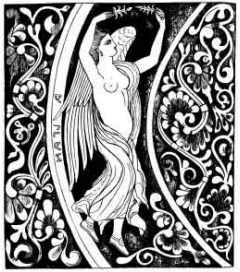 W
WAlbina or The White Goddess is a goddess associated with the dawn and the founding of Great Britain.
 W
WAmenooshihomimi (天之忍穂耳命) or Oshihomimi for short, is the first son of Amaterasu.
 W
WApedemak or Apademak was a lion-headed warrior god worshiped by the Meroitic peoples inhabiting Nubia. In the temple of Naqa built by the rulers of Meroe, Apedemak was depicted as a three-headed leonine god with four arms and as a snake with a lion head. However, he is usually depicted as a man with a lion head.
 W
WArdoksho, also Romanised as Ardochsho, Ardokhsho and Ardoxsho was a female deity of the Kushan Empire, in Central and South Asia during the early part of the 1st millennium CE. She is considered as an east Iranian fertility goddess. She is known in the Avesta as Ashi.
 W
WIn Gallo-Roman religion, Dea Aveta was a mother goddess, also associated with the freshwater spring at Trier in what is now Germany. Aveta is known mainly from clay figurines found at Toulon-sur-Allier in France and at Trier. These figurines show the goddess with infants at the breast, small lap-dogs, or baskets of fruit. There was a temple dedicated to Aveta in the Altbachtal complex at Trier. Her name is also known from inscriptions found in Switzerland and the Côte-d'Or (France).
 W
WAyizan is the loa of the marketplace and commerce in Vodou, especially in Haiti.
 W
WBattabara 跋陀婆羅 is the Japanese patron deity of baths and bathing. Originally a Buddhist monk from India, Battabara supposedly achieved enlightenment whilst entering the communal bath.
 W
WBieggolmai, Biegolmai, Biegkålmaj, or Bieggålmåj was the unpredictable deity of the summer winds and storms in Sami religious practice
 W
WBixiao Niangniang, also known as Zhao Bixiao, is a Chinese goddess of childbirth. She is the youngest of the Sanxiao Shengmu or Sanxiao Niangniang. Sanxiao Niangniang is also worshipped as the household deity or toilet god. It is said "the kitchen god was in the kitchen and Sanxiao was in the cottage".
 W
WDaode Tianzun, also known as Taishang Laojun is a high Taoist god. He is the Taiqing which is one of the Three Pure Ones, the highest divinities of Taoism.
 W
WDatsue-ba is an old woman who sits at the edge of the Sanzu River in the Buddhist underworld. At the river, she has two primary duties.
 W
WThe Eight Great Yakṣa Generals, or simply the Eight Yakṣa Generals are guardian deities in Buddhism. They are retainers of Vaiśravaṇa, guardian of the north and king of the yakṣas.
 W
WElegua is an Orisha, a deity of roads in the religions of Santería, Umbanda, Quimbanda, and Candomblé. He is syncretized with Saint Michael, Saint Anthony of Padua, or Holy Infant of Atocha.
 W
WSri Hemadryambha is the golden goddess regarded as the gramadevatha of the Bannur municipal town region located next to the Kodanda Rama Deva temple. She is regarded as the one of the Saptha Matruka's where the other forms of the goddess are associated with nearby districts.
 W
WHendursaga is the god of law in Sumerian, Babylonian, and Akkadian mythology. He was titled by Gudea of Lagash “herald of the land of Sumer.”
 W
WIn Etruscan religion, Hercle, the son of Tinia and Uni, was a version of the Greek Heracles, depicted as a muscular figure often carrying a club and wearing a lionskin. He is a popular subject in Etruscan art, particularly bronze mirrors, which show him engaged in adventures not known from the Greek myths of Heracles or the Roman and later classical myths of Hercules.
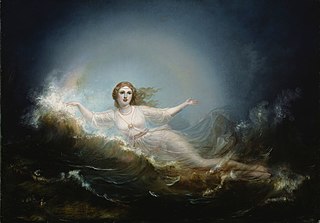 W
WIn the Kalevala, the Finnish national epic, Ilmatar was a virgin spirit of the air.
 W
WInle is the orisha of health and all medicinal healing in Santeria, and also in Candomblé and Palo Mayombe. Inle, also known as Erinle, is an Orisha who is associated with the estuary, an in-between space where the freshwater river meets the salty sea. He is the deity of health and medicine, the physician to other deities, hunter of the land and sea, and is often regarded as the patron of homosexual and transgender people. According to Yoruba tradition, Inle was a mighty hunter who became deified. He is also syncretized with the Archangel Raphael, whose name signifies "God heals." Raphael is frequently shown with fish, wearing blue and pink, and is the patron of nurses, doctors, and other medical workers.
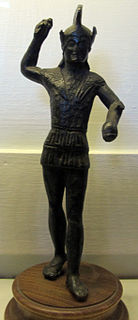 W
WIn Etruscan mythology and religion, Laran is the god of war. In art, he was portrayed as a naked youth wearing a helmet, a cuirass and carrying a spear, shield, or lance. Laran also appears to be an underworld god. Among his attributes is his responsibility to maintain peace. According to some scholars, he also seems to have been the guardian of boundaries as shown by the boundary cippi found in Bettona with the inscriptions tular Larna and tular larns. Along with eight other Etruscan gods, he can wield lightning. Due to the Tabula Capuana we know that the Laran festival was celebrated on the Ides of May. Laran is the Etruscan equivalent of the Greek Ares and the Roman Mars. Like many other Etruscan gods, his name is gender neutral.
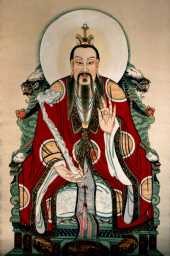 W
WLingbao Tianzun, also known in English as the Heavenly Lord of Spiritual Treasures, is a Taoist god. Also known as Shangqing, he is numbered among the Three Pure Ones who head some forms of the Taoist pantheon.
 W
WMa Yuan (马元) is a character from the Chinese novel Fengshen Yanyi. Ma Yuan is described as a human eating demon who became a Buddha.
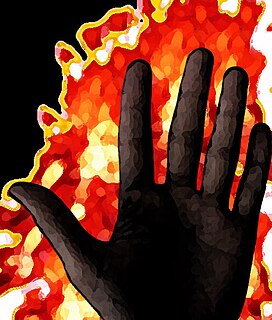 W
WMahuika is a Māori fire deity. Generally, Mahuika is female and wife of the god Auahitūroa.
 W
WMaman Brigitte sometimes also written as Manman Brigitte and also known by Gran Brigitte, Grann Brigitte, Manman, Manman Brigit, and Maman Brijit is a death loa and the consort of Baron Samedi in Haitian Vodou. She drinks rum infused with hot peppers and is symbolized by a black rooster. Like Samedi and the Guede, she is foul-mouthed. Maman Brigitte also has the distinction of being the only loa who is depicted as being White. She is also the adoptive mother of Guede Nibo.
 W
WMuzha is a figure in Chinese mythology and a god in Chinese traditional religion.
 W
WNamtar, was a chthonic minor deity or demon in Mesopotamian mythology, god of death, and sukkal and messenger of An, Ereshkigal, and Nergal.
 W
WOkó, also known in Brazil as Ocô, is an Orisha. In Nigeria and the Benin Republic, he is a strong hunter & farming deity as well as a fighter against sorcery. He is associated with the annual new harvest of the white African yam. Among the deities, he is considered a close friend of Oosa Ogiyan and Shango, as well as at one time husband of Oya and Yemoja. Bees are considered the messengers of Oko.
 W
WPrincess Longji (龙吉公主) is a Chinese goddess and character in the classic Chinese novel, Fengshen Yanyi. She is the daughter of the Emperor of the Heaven, Haotian Shangdi, identified with the Jade Emperor, and his wife Yaochi Jinmu, identified with the Queen Mother of the West.
 W
WQiongxiao Niangniang, also known as Zhao Qiongxiao, is a Chinese goddess of childbirth. She is the second of the Sanxiao Shengmu or Sanxiao Niangniang. Sanxiao Niangniang is also worshipped as the household deity or toilet god. It is said "the kitchen god was in the kitchen and Sanxiao was in the cottage".
 W
WIn Māori mythology, Rehua is a very sacred personage, who lives in Te Putahi-nui-o-Rehua in Rangi-tuarea, the tenth and highest of the heavens in some versions of Māori lore. Rehua is identified with certain stars. To the Tūhoe people of the North Island he is Antares. Others say he is Betelgeuse, or Sirius. Because he lives in the highest of the skies, Rehua is untouched by death, and has power to cure blindness, revive the dead, and heal any disease. He is a son of Rangi and Papa, and the father of Kaitangata, as well as the ancestor of Māui. A Ngāi Tahu legend from the South Island speaks of Rehua as the eldest son of Rangi and Papa, who first manifested as lightning, but assumed human shape when he travelled into the skies. Later his brother Tāne went to pay him a visit, Rehua had birds in his hair, feeding on his lice. Rehua had his servants cook and prepare the birds as a meal for Tāne, who was shocked and declined to eat them because the birds had eaten the lice from Rehua's head, which was extremely tapu (sacred). However Rehua gave him birds to bring down to this world, and showed him how to snare them. Tāne also brought with him the fruit trees that the birds fed on, and so it is that there are forests and birds on the earth.
 W
WIn Māori mythology, Rūaumoko is the god of earthquakes, volcanoes and seasons. He is the youngest son of Ranginui and Papatūānuku.
 W
WSandon was a god in ancient Tarsus, visually represented as a mitre-wearing human form carrying a sword, a flower, or (commonly) an axe who stands on the back of a horned and winged lion. Associated primarily with war and weather, Sandon was the chief god in the Cilician pantheon from at least the beginning of the second millennium BC. The ancient Greeks and Romans equated Sandon with Herakles. A large monument to Sandon existed at Tarsus at least until the third century AD.
 W
WSanshin or Sansin are local mountain-spirits in Korean Shamanism and folk-beliefs. In South Korea, most Buddhist temples and major Shamanic-shrines, and some traditionalist villages have a dedicated shrine called a sanshin-gak or an altar called a sanshin-dan dedicated to the local sanshin. This nature-deity is typically represented in the enshrined icons as an elder male figure in royal-Confucian clothing, always accompanied by at least one tiger and a Korean Red Pine tree. There are many other symbols being held by the Sanshin, offered to him by servants or in the backgrounds of the more elaborate paintings, derived from Oriental Daoism, Buddhism, Neo-Confucianism, shamanic-folklore and Korean 'spiritual-ethnic nationalism' -- making these multi-religious icons unique in the entire world.
 W
WSatre or Satres was an Etruscan god who appears on the Liver of Piacenza, a bronze model used for haruspicy. He occupies the dark and negative northwest region, and seems to be a "frightening and dangerous god who hurls his lightning from his abode deep in the earth." It is possible that Satre is also referred to with the word "satrs" in the Liber Linteus, the Etruscan text preserved in Ptolemaic Egypt as mummy wrappings.
 W
WShivini, also known as Siuini, Artinis, Ardinis, was a solar god in the mythology of the Iron Age kingdom of Urartu in the Armenian Highlands. He is the third god in a triad with Khaldi and Theispas. The Assyrian god Shamash is a counterpart to Shivini. He was depicted as a man on his knees, holding up a solar disc. His wife was most likely a goddess called Tushpuea who is listed as the third goddess on the Mheri-Dur inscription.
 W
W"Sidaba Mapu" or Salailel is the Supreme God, Creator of the universe and the Sky God in Meitei mythology and religion. According to Kanglei mythology, Sidaba Mapu, being the Creator of the Universe, from a philosophical theory known as Leithak Leikharol Nongsemlon and Leisemlon.
 W
WIn Etruscan Religion and mythology, Thesan is the Etruscan goddess of the dawn, divination and childbirth and was associated with the generation of life. She was identified with the Roman Aurora and Greek Eos. However, she was also interpretio graeca with Leucothea and interpretio romana with Mater Matuta. In Etruria, she received offerings together with the sun god Usil in the liber linteus. She was especially worshipped at Caere and the city’s harbor Pyrgi, where a singular series of ‘‘daybreak antefixes’’ was excavated.
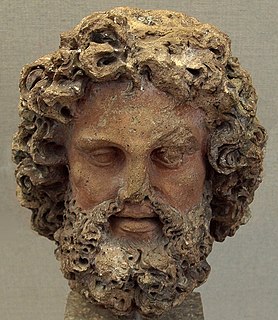 W
WIn Etruscan religion and mythology, Tinia was the god of the sky and the highest god in Etruscan mythology, equivalent to the Roman Jupiter and the Greek Zeus. However, a primary source from the Roman Varro states that Veltha, not Tins, was the supreme deity of the Etruscans. This has led some scholars to conclude that they were assimilated, but this is speculation. He was the husband of Uni and the father of Hercle. Like many other Etruscan deities, his name is gender neutral.
 W
WIn Polynesian mythology, stories about Tinirau are found throughout the islands of Polynesia. He is a guardian of fish. Many themes recur in the various versions. Often he travels to another land in search of his wife, or his wife travels to another land in search of him; sometimes he treats his wife badly, or she rejects him; while he is guardian of fish, it is his wife who gives the fish their individual characteristics. Sometimes their anxious or jealous relatives try to separate the lovers.
 W
WTū-te-wehiwehi is the father of all reptiles in Māori mythology.
 W
WTừ Đạo Hạnh also thánh Láng, was a Vietnamese monk who lived at the Thay Pagoda near modern Hanoi. Various folk legends are told about his life and powers. Today when puppeteers perform during the Thay Pagoda Festival, on the seventh day of the third lunar month, they honor Tu Dao Hanh as their founder and patron deity.
 W
WIn Etruscan religion, Turms was the equivalent of Roman Mercury and Greek Hermes, both gods of trade and the messenger god between people and gods. He was depicted with the same distinctive attributes as Hermes and Mercury: a caduceus, a petasos, and/or winged sandals. He is portrayed as a messenger of the gods, particularly Tinia (Jupiter), although he is also thought to be ‘at the service’ (ministerium) of other deities.
 W
WUṣṇīṣavijayā is a buddha of longevity in Buddhism. She wears an image of Vairocana in her headdress. With Amitayus and Sitatara, she constitutes the three Buddhas of long life. She is one of the more well-known Buddhist divinities in Nepal, Tibet, and Mongolia.
 W
WVellamo, also spelled Wellamo, is the goddess of water, lakes and seas in Finnish mythology.
 W
WVirūḍhaka is a major deity in Buddhism. He is one of the Four Heavenly Kings and a dharmapala.
 W
WVishwambhari Maa is goddess of Karma. She is Prakriti. She is the Supreme Being. Also known and referred as Adishakti. Vishvambhari Maa is the creator of the entire Universe. She is the one who created the Hindu Trinity of Brahma, Vishnu and Mahesh. She is the one who created the many species residing on this planet.
 W
WXianhe Tongzi, also known as Baihe Tongzi, is a Chinese deity who is worshipped in temples and shrines as a spiritual power for getting rid of negative forces, as well as a deity of bravery, determination, intelligence.
 W
WA Yamari is a yidam or meditation deity of the Anuttara Yoga Tantra method (father) classification. The Word यमारि yamāri in Sanskrit means Yama's Enemy There are three types of Yamari:Krishna Yamari Rakta Yamari Yamantaka sometimes referred to as Vajrabhairava
 W
WYogambara, is a tutelary deity in Tibetan Buddhism belonging to the Wisdom-mother class of the Anuttarayoga Tantra.
 W
WYu Shiqie is a Chinese spirit or goddess of rain. She appears in the Classic of Mountains and Seas as the leader of a country called Yu Shi (雨师国). Yu Shiqie and Yu Shi were in a relationship.
 W
WYunxiao Niangniang, also known as Zhao Yunxiao, is a Chinese goddess of childbirth. She is the oldest of the Sanxiao Shengmu or Sanxiao Niangniang. Sanxiao Niangniang is also worshipped as the household deity or toilet god. It is said "the kitchen god was in the kitchen and Sanxiao was in the cottage".
 W
WZangbeto are the traditional voodoo guardians of the night among the Ogu or Egun people of Benin, Togo and Nigeria. A traditional police and security institution, the Zangbeto cult is charged with the maintenance of law and order, and ensures safety and security wigu communities. They are highly revered and act as an unofficial police force patrolling the streets, especially in the night, watching over people and their properties, and tracking down criminals and presenting them to the community to punish. Originally created to scare the enemy away, Zangbeto will wander the streets to detect thieves and witches, and to protect law and order.
 W
WZé Pilintra is a phalanx of entities of light originating from the syncretic belief called Catimbó, which arose in the Northeast of Brazil. Zé Pilintra is also commonly "incorporated" in Umbanda temples, with his cult spread throughout Brazil. In this religion, it can be considered part of the line of work of right ou left.
 W
WZhunti Daoren (准提道人) is a character from the Chinese classic novel Fengshen Yanyi. He is a heavenly saint come from the Western Heaven, the land of Buddha. His rank is high and equal with Taishang Laojun and Yuanshi Tianzun from the East. Zhunti Daoren is the brother of Jieyin Daoren. He carried the wisdom from the West and teachings of the Buddha's laws together with his brother and enlightened the people of the Shang Dynasty. He once rushed from the West to the East to help Jiang Ziya conquer the peacock spirit Kong Xuan as a mount, and later transformed him into Mahamayuri. He also once subdued Ma Yuan, who had eaten human's hearts, brought back to the Western Heaven and transformed into Ma Yuan Zunwang Buddha (马元尊王佛).
 W
WZhurong, also known as Chongli, is an important personage in Chinese mythology and Chinese folk religion. According to the Huainanzi and the philosophical texts of Mozi and his followers, Zhurong is a god of fire and of the south. The Shanhaijing gives alternative genealogies for Zhurong, including descent from both the Yan Emperor and Yellow Emperor. Some sources associate Zhurong with some of the principal early and ancient myths of China, such as those of Nüwa, Gonggong, and the Great Flood. Chinese mythology has in the past been believed to be, at least in part, a factual recording of history. Thus, in the study of historical Chinese culture, many of the stories that have been told regarding characters and events which have been written or told of the distant past have a double tradition: one tradition which presents a more historicised and one which presents a more mythological version. This is also true in the case of Zhurong. In Sima Qian's Records of the Grand Historian, Zhurong is portrayed as a historical person, who held the governmental office of Minister of Fire.